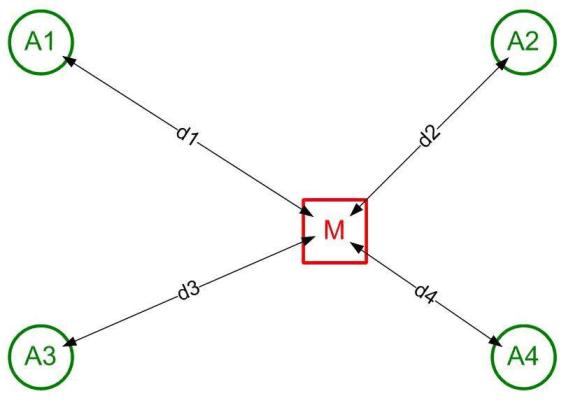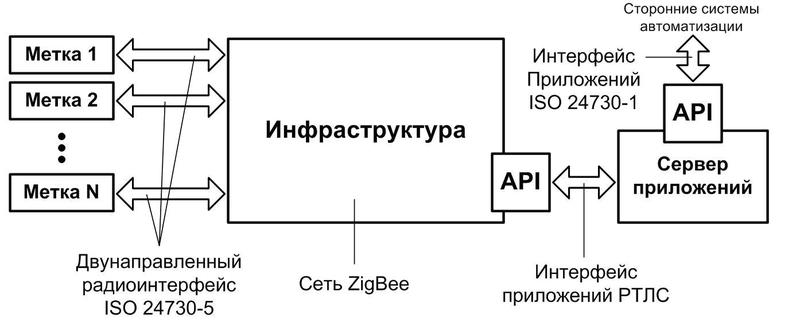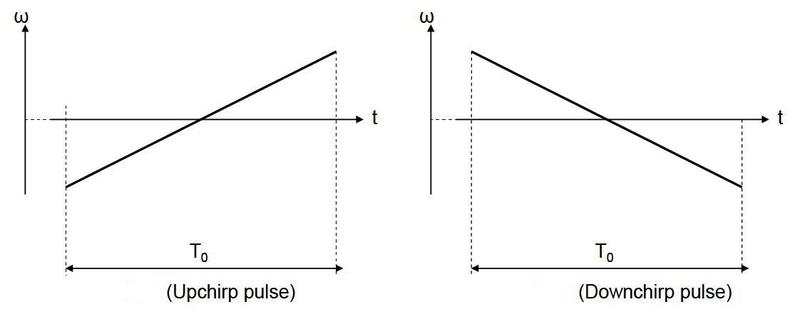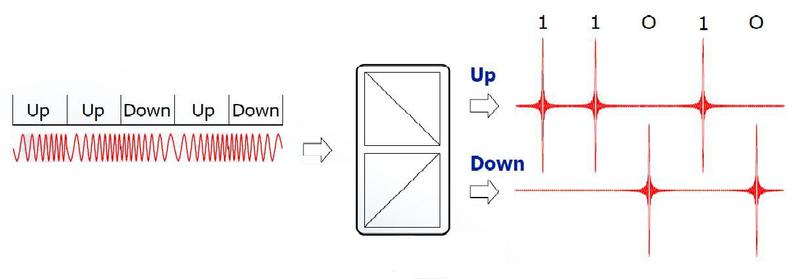CSS (ISO 24730-5) distance Measurement without roulette and wires
In a previous topic I told about the first Russian system of positioning in real-time. This topic is for those who are interested in "how it works". Start with measuring the distance by radio-frequency.
To determine the location of the labels on the plan RTLS, OOO uses the method of calculating the location of each label, based on the measured alignment mark (M) of the distances to three or more anchors (A) having a known position in space, as shown.

To measure distances use two technologies, namely:
CSS (Chirp Spread Spectrum) – using short chirp pulses and
SDS-TWR (Symmetrical Double-Sided Two Way Ranging) – symmetric two-way bi-directional distance measurement.
The technology is based on measuring the propagation time of the radio signal from the transmitter to the receiver (time of flight) and comply with the international standards ISO 24730-5 and IEEE 802.15.4-2011, respectively.
This topic is dedicated to the CSS technology.
CSS is, how it is applied RTLS, OOO, different:
1) optimal for most industrial applications, measurement accuracy (accuracy of one meter distance up to 30 meters with 90% confidence) on the premises;
2) high noise immunity;
3) resistance to multipath fading;
4) minimum energy consumption label (for increasing the duration of battery life without recharging);
5) minimum cost.
Structural scheme shown in the figure.

Distance measurement is carried out in the system of labels, which exchange packets with the elements of the infrastructure through a bidirectional radio interface corresponding to ISO standard 24730-5. Infrastructure via application programming interface (API applications RTLS) connected with the server management infrastructure, process labels and measurements and to obtain measurement results and status information from the labels. The infrastructure in system of RTLS is composed of zones of a wireless mesh network, ZigBee (IEEE 802.15.4) associated with the server IP channels. Each base station ZigBee network has an additional radio interface for communication with the tags. (RTLS infrastructure will be dedicated to one of the following topics).
The server in turn has an external standard API, which allows you to transfer received data to other automated systems.
In the system RTLS tags are not part of the network do not participate in routing and data translation, that is, freed from all except the distance measurement and transmission of measurement results via the transport network to the server. This allowed to simplify labels and reduce their power consumption and price.
Marks interact with the infrastructure through the shown bi-directional radio interface.

For this interface ISO 24730-5 defined frequency range, a form of signal modulation, encoding, packet formats, commands, and other settings. Protocol stack interface includes:
PHY – the physical layer, which defines the parameters of the transfer environment (the operating frequency, channel width, etc.);
MAC – the level of access to the environment that specifies the encoding parameters, packet format, etc.;
API – application level, which determines the state label and the manner of their changes, a list of the commands and their parameters, the protocols of the exchange of packages with infrastructure elements and so on.
At the time of switching the state of the label – source, use "default profile". Label periodically send short multicast packets – Blinky. Every blink contains physical address tags, status, and time information when the label is ready to accept commands from the infrastructure.
If the label does not receive in a certain time the next command, it returns to initial state (to use "default profile") and periodically send Blinky to restore the connection. Learn more about the States label, control commands and can be read in the Appendix of the article on the website of RTLS www.rtlsnet.ru/technology/view/2.
In the CSS technology are used "chirp" pulses (in a literal translation means chirp chirp, and speaking in Russian, CSS nano-frequency modulation – chirp). Chirp pulses – pulses of monotonically increasing or decreasing frequency. The lower and upper frequency chirp of the pulse correspond to the boundaries defined by the standard frequency range.
In nature, dolphins and bats millions of years measure distance using Chirp pulses. In radar chirp pulses are first applied and patented by Professor Guttmann in the 1940s. Firm Canon in the mid-1990s, has patented the use of chirp pulses in fiber-optic systems. And in 1996 Nanotron Technologies began research and later patented the CSS for wireless data transmission.
CSS – radio-frequency technology, is best suited for cases where a particularly important communication reliability and low power consumption for battery powered devices (battery–powered). The data transfer speed according to the technology of CSS – medium (up to 2 MB/s).
Any package CSS is transmitted Chirp pulses of two types: increasing (Upchirp) or decreasing (Downchirp) frequency, as shown in the drawings.


ISO 24730-5 CSS sets the center frequency of 2.45 GHz, a bandwidth of 80 MHz and a fixed pulse duration is 1 µs.
CSS technology transmission information is coded by a sequence of Chirp pulses. The symbol "1" corresponds to the Upchirp pulse, the symbol "0" – Downchirp pulse. The decoding sequence is performed by two complementary (complementary) dispersive delay lines (d-line). The coded sequence is fed to the inputs of the two lines, but the d-line parameters are selected so that signals of different frequencies are passed through a d-line with different speeds. In one a d-line (figure – Up) high frequency propagate through the delay line faster, a second faster like low frequencies. The result Upchirp pulse that starts low and ends high frequencies, passing through a d-line Up "shrink" in time. The high-frequency end "catches" the low-frequency start and is initially uniformly distributed in time pulse energy output manifests in a short pulse whose amplitude is many times greater than the amplitude of the input signal. On the contrary, the Downchirp impulse, passing through the d-line Up, "washed away" in time and its amplitude decreases. Thus, the output of the d-line Up a pulse, which correspond to the symbol "1". The second d-line (the figure Down) faster apply low frequency, thereby "compressed" Downchirp pulses, and the output is a d-line pulses appear, which correspond to the symbol "0".

In addition to decoding the d-line improve resistance to interference and broadband noise. The point is that interference (noise), in contrast to the chirp pulses have a constant frequency spectrum and pass through a d-line without changes. "Compressed" in a d-line chirp pulses have a greater compared to baseline amplitude, and easily stand out against the background noise and interference.
Another advantage of the CSS – stability to multipath attenuation. The transmitter's signal in the 2.4 GHz band typically reaches the receiver in the "maintenance" of several of the echo – reflections from obstacles, or even only in the form of echo signals in the absence of direct visibility. The path of propagation of signals have different length, so the reflection phase-shifted relative to the main signal. In narrowband systems, this leads to disruption of communication. CSS is characterized in that distorted and phase-shifted signals, in General, retain the frequency spectrum, allowing to collect on a d-line almost all the energy allocated 80 megagertsevym band of the original signal.
Article based on information from habrahabr.ru
To determine the location of the labels on the plan RTLS, OOO uses the method of calculating the location of each label, based on the measured alignment mark (M) of the distances to three or more anchors (A) having a known position in space, as shown.

To measure distances use two technologies, namely:
CSS (Chirp Spread Spectrum) – using short chirp pulses and
SDS-TWR (Symmetrical Double-Sided Two Way Ranging) – symmetric two-way bi-directional distance measurement.
The technology is based on measuring the propagation time of the radio signal from the transmitter to the receiver (time of flight) and comply with the international standards ISO 24730-5 and IEEE 802.15.4-2011, respectively.
This topic is dedicated to the CSS technology.
CSS is, how it is applied RTLS, OOO, different:
1) optimal for most industrial applications, measurement accuracy (accuracy of one meter distance up to 30 meters with 90% confidence) on the premises;
2) high noise immunity;
3) resistance to multipath fading;
4) minimum energy consumption label (for increasing the duration of battery life without recharging);
5) minimum cost.
Structure of the positioning system RTLS
Structural scheme shown in the figure.

Distance measurement is carried out in the system of labels, which exchange packets with the elements of the infrastructure through a bidirectional radio interface corresponding to ISO standard 24730-5. Infrastructure via application programming interface (API applications RTLS) connected with the server management infrastructure, process labels and measurements and to obtain measurement results and status information from the labels. The infrastructure in system of RTLS is composed of zones of a wireless mesh network, ZigBee (IEEE 802.15.4) associated with the server IP channels. Each base station ZigBee network has an additional radio interface for communication with the tags. (RTLS infrastructure will be dedicated to one of the following topics).
The server in turn has an external standard API, which allows you to transfer received data to other automated systems.
In the system RTLS tags are not part of the network do not participate in routing and data translation, that is, freed from all except the distance measurement and transmission of measurement results via the transport network to the server. This allowed to simplify labels and reduce their power consumption and price.
Marks interact with the infrastructure through the shown bi-directional radio interface.

For this interface ISO 24730-5 defined frequency range, a form of signal modulation, encoding, packet formats, commands, and other settings. Protocol stack interface includes:
PHY – the physical layer, which defines the parameters of the transfer environment (the operating frequency, channel width, etc.);
MAC – the level of access to the environment that specifies the encoding parameters, packet format, etc.;
API – application level, which determines the state label and the manner of their changes, a list of the commands and their parameters, the protocols of the exchange of packages with infrastructure elements and so on.
system
At the time of switching the state of the label – source, use "default profile". Label periodically send short multicast packets – Blinky. Every blink contains physical address tags, status, and time information when the label is ready to accept commands from the infrastructure.
If the label does not receive in a certain time the next command, it returns to initial state (to use "default profile") and periodically send Blinky to restore the connection. Learn more about the States label, control commands and can be read in the Appendix of the article on the website of RTLS www.rtlsnet.ru/technology/view/2.
Technology distance measurement: Chirp Spread Spectrum (CSS)
In the CSS technology are used "chirp" pulses (in a literal translation means chirp chirp, and speaking in Russian, CSS nano-frequency modulation – chirp). Chirp pulses – pulses of monotonically increasing or decreasing frequency. The lower and upper frequency chirp of the pulse correspond to the boundaries defined by the standard frequency range.
In nature, dolphins and bats millions of years measure distance using Chirp pulses. In radar chirp pulses are first applied and patented by Professor Guttmann in the 1940s. Firm Canon in the mid-1990s, has patented the use of chirp pulses in fiber-optic systems. And in 1996 Nanotron Technologies began research and later patented the CSS for wireless data transmission.
CSS – radio-frequency technology, is best suited for cases where a particularly important communication reliability and low power consumption for battery powered devices (battery–powered). The data transfer speed according to the technology of CSS – medium (up to 2 MB/s).
How it works
Any package CSS is transmitted Chirp pulses of two types: increasing (Upchirp) or decreasing (Downchirp) frequency, as shown in the drawings.


ISO 24730-5 CSS sets the center frequency of 2.45 GHz, a bandwidth of 80 MHz and a fixed pulse duration is 1 µs.
CSS technology transmission information is coded by a sequence of Chirp pulses. The symbol "1" corresponds to the Upchirp pulse, the symbol "0" – Downchirp pulse. The decoding sequence is performed by two complementary (complementary) dispersive delay lines (d-line). The coded sequence is fed to the inputs of the two lines, but the d-line parameters are selected so that signals of different frequencies are passed through a d-line with different speeds. In one a d-line (figure – Up) high frequency propagate through the delay line faster, a second faster like low frequencies. The result Upchirp pulse that starts low and ends high frequencies, passing through a d-line Up "shrink" in time. The high-frequency end "catches" the low-frequency start and is initially uniformly distributed in time pulse energy output manifests in a short pulse whose amplitude is many times greater than the amplitude of the input signal. On the contrary, the Downchirp impulse, passing through the d-line Up, "washed away" in time and its amplitude decreases. Thus, the output of the d-line Up a pulse, which correspond to the symbol "1". The second d-line (the figure Down) faster apply low frequency, thereby "compressed" Downchirp pulses, and the output is a d-line pulses appear, which correspond to the symbol "0".

In addition to decoding the d-line improve resistance to interference and broadband noise. The point is that interference (noise), in contrast to the chirp pulses have a constant frequency spectrum and pass through a d-line without changes. "Compressed" in a d-line chirp pulses have a greater compared to baseline amplitude, and easily stand out against the background noise and interference.
Another advantage of the CSS – stability to multipath attenuation. The transmitter's signal in the 2.4 GHz band typically reaches the receiver in the "maintenance" of several of the echo – reflections from obstacles, or even only in the form of echo signals in the absence of direct visibility. The path of propagation of signals have different length, so the reflection phase-shifted relative to the main signal. In narrowband systems, this leads to disruption of communication. CSS is characterized in that distorted and phase-shifted signals, in General, retain the frequency spectrum, allowing to collect on a d-line almost all the energy allocated 80 megagertsevym band of the original signal.
Комментарии
Отправить комментарий